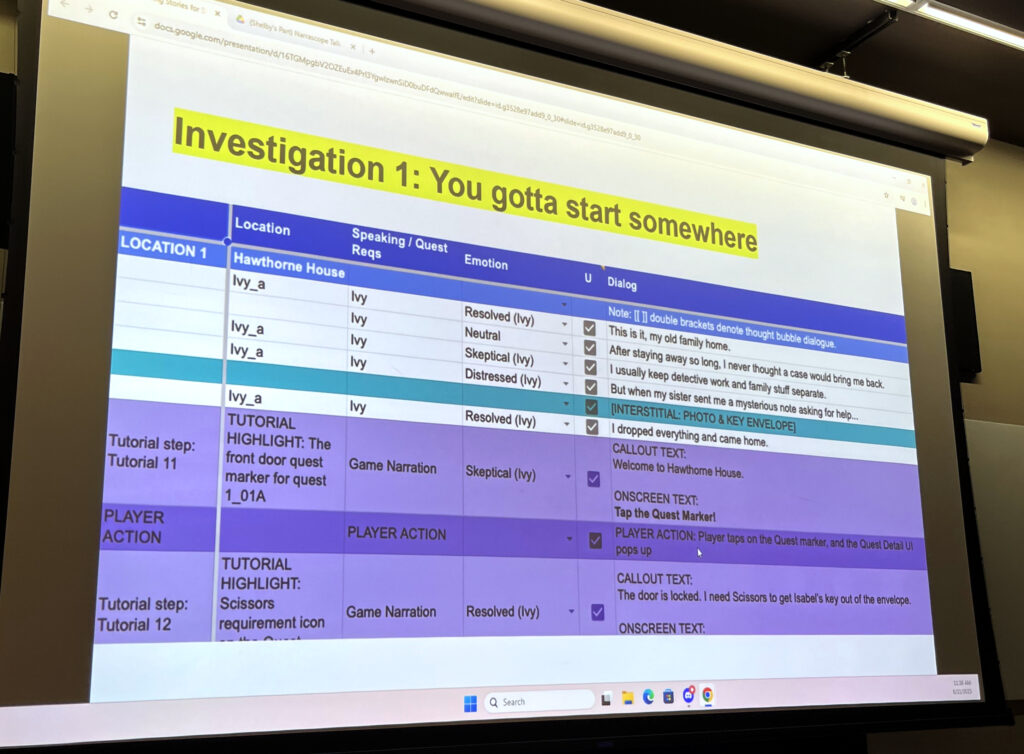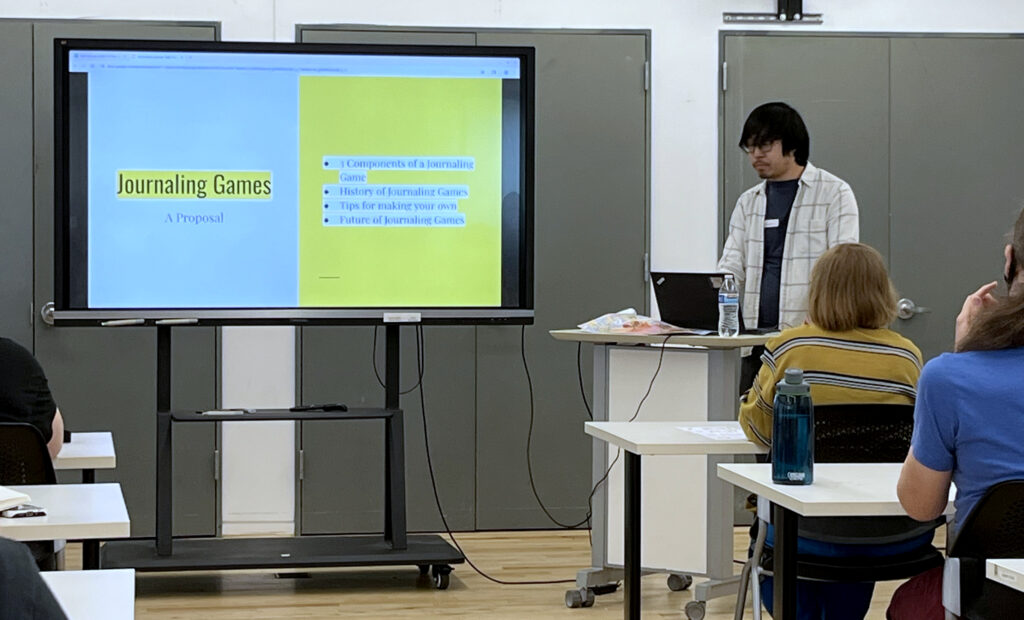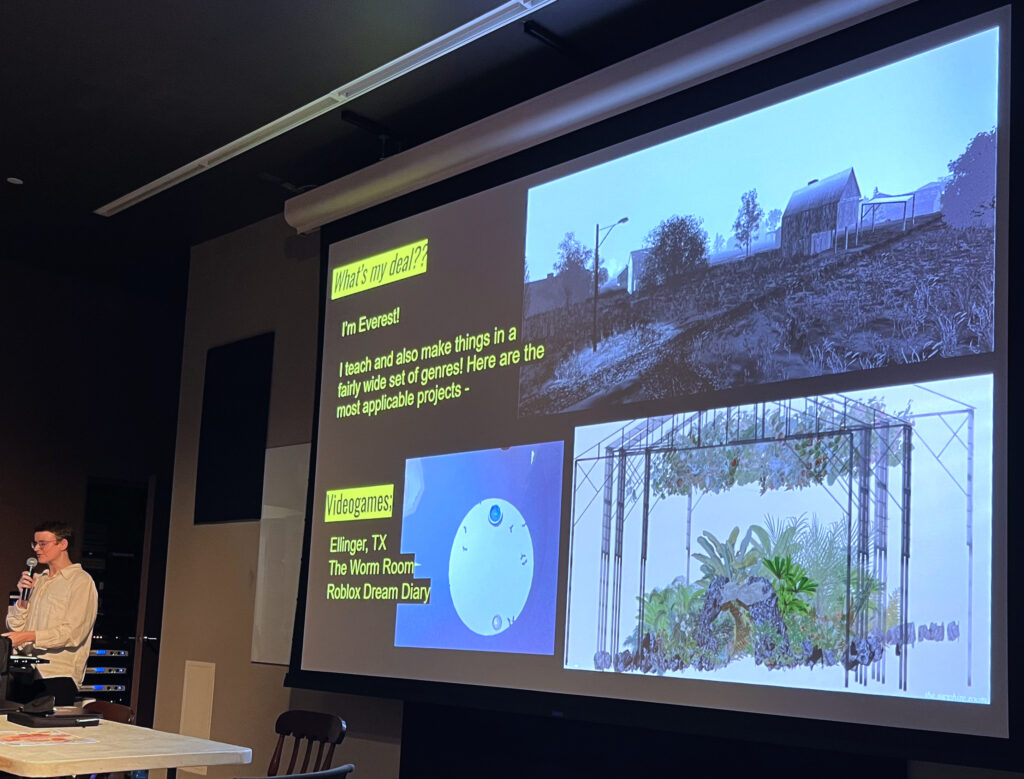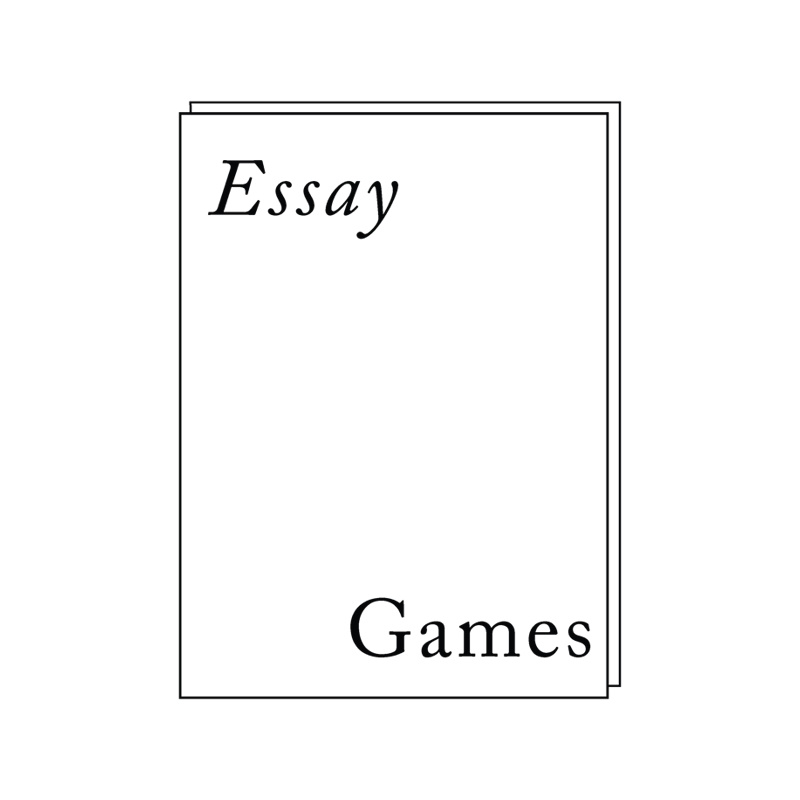
I’m currently sitting in an overcrowded, overheated, delayed Amtrak train after attending NarraScope, and even in these not-so-ideal circumstances, I’m ending the weekend filled with ideas and optimism.*
I was thrilled to deliver a talk about reading children’s books and (re)thinking through narrative design techniques I’ve learned from Susan O’Connor’s tutelage (which I previewed last week). I was scheduled for the last time slot on Saturday, and I was happy that I decided to err on the side of humor because even I, as the speaker, was a bit weary after a full day of thinking, conversations, and enlightening presentations. But folks laughed (appropriately) and responded to the content well, asking poignant questions about craft, inspiration, and design intention.
But I wanted to focus on what I saw while at the conference and give a (not so) brief, non-exhaustive overview of some of the talks that stood out to me and ideas I’ll be taking away from one of the best conferences I’ve been to since before the pandemic. In broad strokes, one of the best things about the conference was its size. There were about 200 in-person attendees, according to opening remarks by conference chair Matthew Griffin. Which I initially thought was a bit small, but made the gathering feel communal, approachable, and never intimidating, even when “big names” in the community were presenting.
Part of this was the venue: Drexel University’s URBN Center was well-equipped to handle sessions of varying sizes. Even in the seminar rooms where most of the talks were held, an audience of 15 engaged and excited attendees still felt “sizable.” But in those same spaces, a crowd could grow to 35 people and still fit quite comfortably. Outside of individual conference rooms, the lobby housed almost the entire in-person community during lunch (which I thought was particularly well-catered) and coffee breaks without much conflict (if a bit loud and overstimulating at peak use). And even though the conference stretched between two buildings, they were across the street from one another, so moving between them during 15-minute breaks never felt rushed.
Matt Griffin asked me to help host some of the talks as a volunteer to welcome and introduce presenters, keep time, and lightly moderate Q&A. Admittedly, this was a bit stressful to start since I was focusing a lot on giving speakers ample warning when sessions were coming to a close instead of the content of the talks. This came to a head when I foolishly told Matt Carney (more on his talk in a sec) that his time was wrapping up when he actually had another half hour to talk (I hadn’t even thought to check the schedule to see he was giving an hour-long talk). But thankfully, he and all the speakers were very gracious, understanding, and patient with small technical hiccups here and there (and huge kudos and thanks to the skeletal volunteer event staff who kept things humming along). I will say that Sunday ran much smoother on a technical and time-keeping side since most of the broadcast issues for virtual attendees had been ironed out by the end of Saturday (again due to the superb work of the conference staff).
But what about the talks?!
My slight preamble about volunteering sets the stage (lol) for admitting that I didn’t get a chance to go to everything I truly wanted to. There were SO MANY GOOD topics and presenters this year that it made deciding which session to attend quite difficult. I’m truly looking forward to seeing all the talks posted online because there were some hard choices that meant not being able to see talks by close friends and notable figures within the interactive fiction and narrative design community. So… even before getting into my highlights, please know this is not even close to being a full list of all the amazing presentations over the weekend.

To start, I had the pleasure of hosting Rose Behar for her talk Writing Absorbing Stories for Short Attention Spans. Pulling from her extensive and highly skilled work as a narrative designer for mobile titles (specifically Ashe Grove), she shared a handy template for writing sharp, witty, emotive, and gripping narrative snippets. She, along with game designer Shelby Moledina, outlined a technique/sequence for creating tight dialog: Tone, Character Voice, Plot, and Game Mechanics (or TCPG). Rose then provided some wonderful behind-the-scenes spreadsheets from Ashe Grove and did a real-time analysis with the audience of how much those snippets adhered to their methodology. Not only was seeing these spreadsheets (pictured) really helpful (I think sharing internal-facing design documents in these contexts can be incredibly instructive), but it also provided an opportunity to do some collaborative critique around the successful implementation of design thinking. Not only was this a very generous gesture by Rose and Shelby, but it also proved tangible examples of where/when design thinking can diverge from the finished product.
The next talk was a lovely, funny, and endearing presentation by DM-less TTRPG designer Brigitte Winter. She focused primarily on her game Psychic Trash Detectives (which I purchased!) and how the game structure allows players to equally participate in collaborative storytelling by internalizing narrative prompts through… well… trash! What I really enjoyed about her talk was not only getting an in-depth overview of the game mechanics (I realized later I had heard about the project on Bluesky and was already following Brigitte), as well as doing a collaborative run-through of the game with the audience. Folks workshopped how a fan could be used to signal and communicate in a fictional underwater burlesque when players were performing their “on-stage persona.” Getting a crash course on setting up Psychic Trash Detectives from the author was great and inspired me to possibly use this game in future teaching environments.

Later on Saturday, I went to Charles Huang’s talk about creating Journaling games as an extension of his Memoir Games project. Charles has been a long-time supporter and enthusiast of Essay Games, and I’ve really enjoyed watching his project grow at various NYC playtesting events over the years. I was taken by his approach to journaling as a way of “tuning out” the noise of social media and online gaming. His emphasis on introverted gameplay and critical self-analysis through role play speaks so deeply to my design values. What I found particularly interesting is how he discussed his game Confessions of an NPC as being a good model for using fantastical or sci-fi elements as a helpful wrapper for talking about heavy socio-political topics. To paraphrase from his talk, “If you add lasers to your game, it makes it easier to talk about systemic inequities.” I really admire Charles and how vulnerable he is in his work. He was candid about his medical trauma during COVID-19 and how much his health scare has shaped (and reshaped) his relationship with game-making. I was so glad to see his work at NarraScope, and I hope to see more artists take his insights into their own designs.
Following this, I hosted Matt Carney’s excellent talk (which I flubbed, so sorry again!) about his experience as an editor for games like NORCO and Perfect Tides: Station to Station (which won the Best in Show award at the first-ever showcase). His talk, entitled Finding the Pixel: Information Seeking Behaviors Towards Holistic Narrative Design, walked through some fascinating strategies for designers to consider, pulled from research into information seeking behavior theories. For the sake of brevity, I won’t detail every single theory, but instead highlight one I thought was particularly of interest: Berrypicking. This theory stipulates that information is rarely found all at once, and is instead accrued over time (and space). As the information gatherer—or player for our purposes—finds valuable “data” they refine their search to address more acute needs. Additionally, players will often use nontraditional methods of inquiry to find the information they desire, not always following the set path to gain what they are seeking. Applying this technique to a narrative design means that you don’t have to overwhelm the player with information all at once, but instead provide “samplings” of data across a range of possible locations, encounters, and waypoints to build information in a more organic and—possibly—engrossing way.
On Sunday, things got started with an absolutely wonderful “local hero” keynote by game designer and former journalist Dain Saint. Dain talked so eloquently about shaping reality through games, steering players toward specific goals/outcomes, and creating works that can speak directly to local communities. What really struck me about Dain’s talk was his ability to distill complex design ideas into remarkably approachable, inspiring, and human concepts. It avoided leaning on fancy design models and flow charts and instead leveraged psychology and interpersonal work to highlight a long-evolving process. One thing he shared that stuck with me was a quote from a friend about the bittersweet feelings that come from ending a project: “Of course you hate your work when you’re close to finishing. It’s because now, as a result of working on it, you’ve become a better artist.” I absolutely love this and will take this generous and self-forgiving sentiment with me for years to come.
After Dain’s keynote, the day’s talks began in earnest, which meant I had the joy of hosting Maxwell Neely-Cohen’s talk, The Magazine Model: Lessons from the HTML Review. I should mention that I’ve known Max since we both participated in ENGINE, a virtual workshop/residency about games and art in 2021, run by Neilson Koerner-Safrata. I’ve also contributed to the HTML Review, an online experimental literary magazine he runs with designer and artist Shelby Wilson (the focus of his talk). What I love about Max is his infectious, candid, witty, and incredibly knowledgeable take on supporting creative communities and elevating projects and makers working in hard-to-define spaces. In his presentation, Max discussed how a magazine is a unique cultural product, one that can have surprising cache within the art world. But he also presented the premise of running an anthology publication as ultimately a passion project; one that should try to position works from first-time authors/makers alongside more established voices.

Next up was Everest Pipkin’s well-researched and wonderfully articulated presentation about “trope grafting” from film to design world-ENDING TTRPGs. Pulling from literary criticism and film theory, Everest mapped out how the traditional cinematic denouement in a three-act structure could be applied more widely within TTRPGs as a way of bringing closure to role-playing experiences. Part of Everest’s interest lies in the ballooning (and subsequent fatigue) of world-building collaborative journaling or map-making TTRPGs like Avery Alder’s The Quiet Year or Everest’s own excellent project The Ground Itself. They discussed the process of making The World Ending Game, a collection of prompts, cues, and scenarios that GMs or campaigns could use to wrap up their adventures in playful, yet meaningful, ways. Though Everest was pressed for time, I would’ve loved to see more conversation about the use of the “camera” in WEG since I know it’s a core component of how GMs can—quite literally—frame conclusions. So much of TTRPGs already use the idea of a roving camera as a way to help visualize the roleplaying space, and as a former filmmaker, I’d love to think about how composition and “edits” could serve as symbolic devices for reaching resolution(s).
After taking lunch and a short break, I went to a very endearing talk by the developers of an upcoming narrative game, Abigail. Built entirely with hand-made sets of paper, pipe cleaners, and felt, Abigail appears to be a touching story about the bittersweet feeling of returning home to a close-knit community after a lengthy time away. Though I loved the aesthetic and the narrative snippets shared, what piqued my interest was the in-game gossip system that relied on the exchange of tiles that could be combined to unlock narrative branches, trigger events in the game world, or even alter the very architecture of the city. Each encounter with your childhood neighbors and local busybodies results in collecting “tiles” that you store in a backpack. NPCs then prompt the player to answer questions using these tiles as a kind of storytelling currency. Depending on your responses, characters react in varying ways, and it’s up to the player to find particular combinations as a form of expressive play. It was hard to tell just yet how this technique would develop in-game, but I’m super excited to follow its development and wishlisted it right away.

To wrap up, the last presentation of the day was more of a workshop on radical self-praise run by effervescent educator A.E. Osworth. In their talk, Sing to Me, Oh Glitch! they walked through a process of naming, critiquing, and then valuing the “glitches” in creative work. These weren’t necessarily technical problems, but areas in the creative process where makers felt “overloaded in unexpected and unavoidable ways.” But instead of identifying issues and trying to “correct” flaws, Osworth instead led a group exercise for channeling one’s inner critic and finding ways of circumventing negative self-talk to discover more empowering and generous modes of analysis. What I really enjoyed about this was not only the helpful tools Osworth shared but also the encouragement to always lean on trusted peers to be a resource for breaking through creative barriers. Additionally, the straightforward methodologies of understanding how and where critiques often come from (and how to identify the relevance of those critiques) were instructive. They talked about misaligned reception of the work (using a phrase I can’t quite remember now…) and how so much of harmful critiques come from a place of just misunderstanding or unwillingness to match the intention of the author. Being able to parse through outside unproductive critique and edge-lord nitpicking gives room for a more radical approach to growth, progress, and reaching your true audience.
So that’s my round-up! Sorry if it’s a bit all over the place and lengthy. There were truly so many amazing presentations throughout the weekend, and the conversations, banter, and critical reflections were such a welcome jolt in my somewhat sleepy creative start to the summer. I can’t wait for all of the talks to appear online in the coming weeks and will be sure to share my own talk when it’s posted!
—
*an absolutely true statement, but mixed with a lot of anxiety about the news of US airstrikes in Iran and the growing probability that we’re entering a new forever war, one that will undoubtedly cause immeasurable strife abroad and at home. I haven’t processed everything that I’m thinking and feeling about this incredibly sad development and I want to say more but first want to try processing my immediate experiences at the conference this past weekend.

Leave a Reply